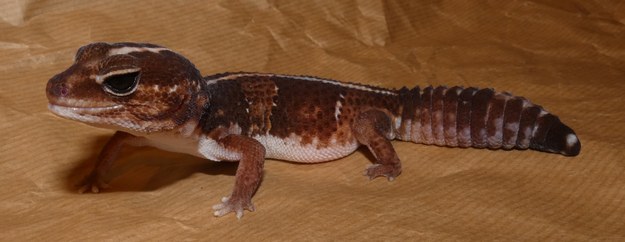(Almost) everyone will grow up eventually
We know from our own experience that people stop growing at a certain age and their height will almost not change after that. It is the same with dogs and budgies, and with all mammals and birds in general. Elementary school students are taught, however, that things are different with reptilians – while they reach a certain adult size relatively soon, their growth potential remains intact and if they live long enough, they can grow even bigger. Is this truly the case with reptilians (Fig. 1)?
 Figure 1. African fat-tailed gecko (Hemitheconyx caudicinctus) – one of the representatives of squamate reptiless. Photo: Petra Frýdlová.
Figure 1. African fat-tailed gecko (Hemitheconyx caudicinctus) – one of the representatives of squamate reptiless. Photo: Petra Frýdlová.
The problem with the classic measurement method used to determine whether or not the growth is finished is that it is extremely difficult. Measuring a lizard once every month is time-consuming, considering that the lizard can live for many decades. The problem with smaller animals is that 1 mm increments are really tough to measure.
Dr Petra Frýdlová from the Department of Zoology of Charles University’s Faculty of Science and her colleagues came up with a new approach: analysing the presence of growth plates in the limbs of squamate reptiles (Squamata). The growth plate is indispensable for the growth of long bones such as the femur. It is a cartilaginous structure in the inner bone architecture, which can be viewed in detail using the X-ray microtomography (µCT) method. µCT uses X-rays to visualise the internal structure of a sample with definition in the order of micrometres (Fig. 2). Without a growth plate, the bone cannot grow lengthwise. In mammals, the growth plate disappears irreversibly (is resorbed) at a certain age, which stops their growth finally.
 Figure 2. Longitudinal section of the proximal epiphysis of the femur captured using X-ray microtomography with the growth plate present (a) and resorbed (b). The asterisk indicates the presence of the growth plate. Photo: Petra Frýdlová
Figure 2. Longitudinal section of the proximal epiphysis of the femur captured using X-ray microtomography with the growth plate present (a) and resorbed (b). The asterisk indicates the presence of the growth plate. Photo: Petra FrýdlováContrary to their expectations, Dr Frýdlová and her colleagues identified this condition in 106 out of the 164 examined lizard species. Even though all young animals had growth plates, the only species that still had growth plates in older individuals were the agama, chameleon and large species of monitor lizards. These three groups retain their growth potential, but the majority of lizards are more like us in this respect. In effect, a European green lizard could not outgrow a green iguana even if it lived for two hundred years.
As was said above, determinate growth is typical for all mammals and birds. The work of Dr Frýdlová and her colleagues has shown that determinate growth is a trait of the majority of reptiles as well. It is possible, then, that determinate growth could have been a trait of the common ancestor of those groups, the ancestor of all amniote terrestrial vertebrates.
Three Czech scientific institutions participated in the project: Faculty of Science, Charles University, the Third Faculty of Medicine, Charles University, and the Institute of Experimental and Applied Physics of Czech Technical University, as well as the Department of Biosciences of the University of Salzburg.
Link to the original article:
Frýdlová Petra, Mrzílková Jana, Šeremeta Martin, Křemen Jan, Dudák Jan, Žemlička Jan, Minnich Bernd, Kverková Kristina, Němec Pavel, Zach Petr and Frynta Daniel 2020. Determinate growth is predominant and likely ancestral in squamate reptiles. Proc. R. Soc. B.28720202737. http://doi.org/10.1098/rspb.2020.2737
Document Actions